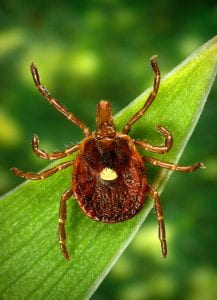Objective: Explore the effect of prescribed fire on tick population dynamics in the Kansas Flint Hills. Continue reading “Reducing Tick Populations Through Prescribed Burning”
Tag: prescribed burning
Summer Burning Reduces Caucasian Bluestem Frequency
by Helen Giefer, ASI graduate student with KC Olson, ruminant nutritionist
While Caucasian and yellow bluestem – collectively referred to as old-world bluestems – continue to spread across the state of Kansas, promising new research may provide landowners with new hope for controlling the invasive species. Upon the discovery that late-summer prescribed fire (August 1 to September 21) successfully set back yellow bluestem, a similar study is now underway for Cacausian bluestem. Continue reading “Summer Burning Reduces Caucasian Bluestem Frequency”
Impact of Seasonal Rangeland Burning for Early Season Tick Control
Cassandra Olds, extension entomologist
 The lone star tick (Amblyomma americanum) is common tick found in Kansas which takes two years to complete development from egg to reproductive adult. Much of this time is spent off the animal host, sheltered in leaf litter particularly in shrubby areas. These areas provide a humid microcosm fundamental for tick survival. Prescribed or controlled burns are carried out to improve a number of rangeland conditions such as weed suppression and improve forage quality. Continue reading “Impact of Seasonal Rangeland Burning for Early Season Tick Control”
The lone star tick (Amblyomma americanum) is common tick found in Kansas which takes two years to complete development from egg to reproductive adult. Much of this time is spent off the animal host, sheltered in leaf litter particularly in shrubby areas. These areas provide a humid microcosm fundamental for tick survival. Prescribed or controlled burns are carried out to improve a number of rangeland conditions such as weed suppression and improve forage quality. Continue reading “Impact of Seasonal Rangeland Burning for Early Season Tick Control”
Effects of Late Summer Prescribed Fire on Botanical Composition, Soil Cover, and Forage Production in Caucasian Bluestem-Infested Rangeland in the Kansas Smoky Hills: Year 2 of 4
Objective: The objective was to document the effects late-summer prescribed fire on soil cover, botanical composition, and forage production in the Kansas Smoky Hills and the associated effects on dense Caucasian bluestem (Bothriochloa bladhii) stands therein.
Study Description: The study took place on a private ranch in Ellsworth County, in the Kansas Smoky Hills. Eighteen one-acre plots were assigned randomly to one of three prescribed-fire treatments: no burn, single burn (i.e., one burn treatment only in 2019), or biennial burn (i.e., two burn treatments in 2019 and 2021). Continue reading “Effects of Late Summer Prescribed Fire on Botanical Composition, Soil Cover, and Forage Production in Caucasian Bluestem-Infested Rangeland in the Kansas Smoky Hills: Year 2 of 4”
Sericea Lespedeza Control from Growing-Season Prescribed Burning Causes No Collateral Damage to Non-Target Species
Objective: The objective of this study was to evaluate the effects of 4 consecutive years of prescribed fire applied to native tallgrass range in either April, August, or September on forage biomass production, soil cover, and basal plant cover.
Study Description: Nine fire-management units (14 ± 6 acres) were burned at 1 of 3 prescribed times: early spring (April 1), mid-summer (August 1), or late summer (September 1). Plant species composition and soil cover were assessed annually each July using a modified step-point technique. Continue reading “Sericea Lespedeza Control from Growing-Season Prescribed Burning Causes No Collateral Damage to Non-Target Species”